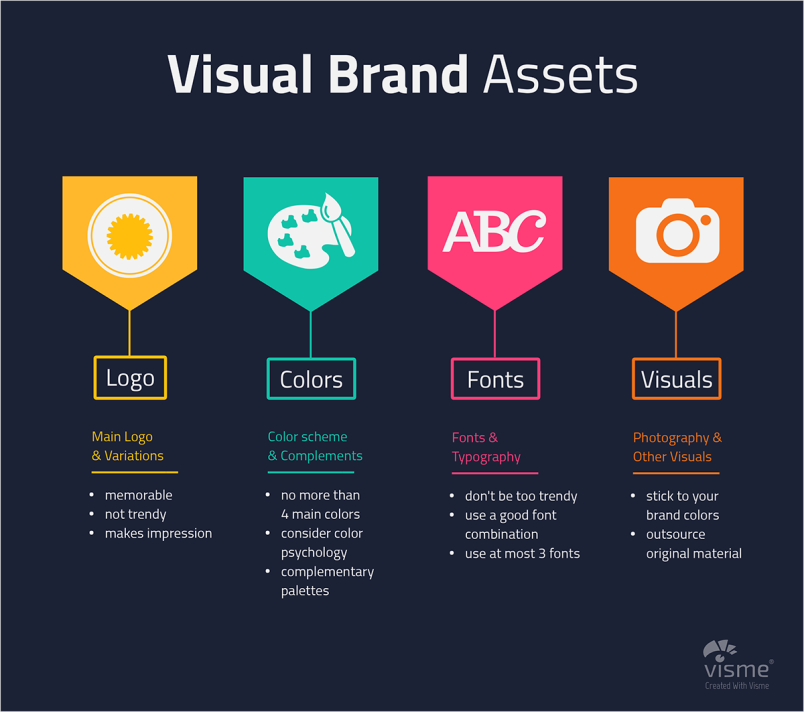Brand Identity

Amazon’s CEO Jeff Bezos says, “Branding is what people say about you when you are not in the room.” Your brand is how your audience perceives your organization as a whole. It’s the lasting impression businesses leave on their customers and clients. It’s shaped largely by the visual identity that businesses present to their customers and clients. Businesses hire top branding and identity services for compelling visual brand identity.
A brand is not only the physical or visual elements that represent your organization. It’s also how people feel when they interact with your business, marketing materials, products, services, team members, and physical locations.
Components of a Visual Brand Identity

All the visible images associated with your organization comprise a businesses’ visual identity. Following are the elements that guide customers and clients to their perceptions of your brand:
- Logo
- Colors
- Typography
- Imagery Styles
- Composition Styles
A combination of those elements makes up your visual brand identity. The visuals represent a larger message and theme. They set the tone for your entire branding. So, it’s important to match your visual identity with the overall identity of your brand.
Also, Read | Resourceful Strategies For Effective Ecommerce Branding
Building Your Visual Brand Identity
Follow these steps to identify your brand goals and mission to connect your visual identity to your larger brand values:
1. Define Your Audience
Before positioning your brand to connect with an audience, have a level of understanding about your audience. It is because, to appeal to their needs and desires. The benefit of Identifying your desired customer base is, it makes every part of your branding process easier. This step assists to determine how to talk to your audience. To talk with the language, terms, and tone best relating to your primary buyer personas.
Define your audience by looking at demographics and psychographics. Use your research to create multiple specific, targeted versions of your buyer personas. Consider your audience’s:
- age, gender, job description, income, and education level
- personality – their values, hobbies, and interests
- lifestyle
- day to day concerns
- solutions they look for
- brands they like
2. Define Your Mission
After spending some time digging into your audience, take some time to assess your company.
What are your offerings to your customers and clients? Apart from your products and services offerings, focus on the way of your offerings and their reasons.
Consider these:
- Reasons for providing these services and products
- What do we hope to change for our customers?
- What improvements do we want to bring to their life?
- Why do we think it’s important to do this?
- What do we stand for?
3. Identify Your Brand Personality
After a good idea about your brand mission, identify the brand personality that matches that position. Also focus on questions such as:
- Which persona would be a good reflection of your business?
- How would they look and talk?
An easy way to create a starting point for this imaginary brand representative is to ask yourself the question:
If there could be any person as a spokesman for my brand, who would it be? From there, begin creating a description of your brand personality. Keep this tone and messaging to use across marketing channels, including social media and email. Keep the personality consistent across each outlet to communicate with your customers.
Related Effective Branding Strategies To Create A Powerful Brand Identity
4. Develop Emotional Appeal
Infusing emotion into your brand connects deeply with prospects and leaves a lasting memorable image in their mind.
- How do we want audiences to feel when they see our marketing materials?
- What are the triggered emotions when your customers and clients use your products/services or interact with your brand?
- What emotions lie at the heart of your brand story?
The answers to these questions act as the building blocks for your brand marketing strategy.
5. Build Your Visual Brand
Answers to those questions assist in naturally building an image of your brand and the visuals that support it.
Use the following information to build your visual brand:
- Choose a color palette. Color psychology can guide in picking a shade that matches your identity.
- Choose your typography. Choose two complementary fonts that represent your brand.
Define imagery choices. Detailing the imagery that best represents your brand.
6. Keep Your Brand Consistent
Consistency is one of the most critical strategies for marketing a brand. But it’s becoming increasingly difficult to maintain that consistency in our evolving world of multi-channel marketing.
To unify all these communication channels to present a clear, concise, and consistent brand identity revolves around brand style, substance, and story.
Conclusion
Working with a hodgepodge of confusing and inconsistent visuals doesn’t bring desired results. Begin making changes by clearly setting your visual brand identity with the strategies that we discussed. Contact Oodles branding and design services for more assistance.
Image Source – Google images



